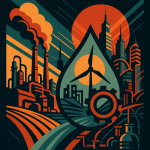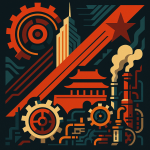“`html
Powering the Future: Why China is Going All-In on Small Nuclear Reactors (SMRs) for Data Centers and Beyond
Key Points
- China is exploring Small Modular Reactors (SMRs) to power data centers, driven by the massive energy demands of AI and climate goals.
- Major Chinese IT and transportation firms are already conducting feasibility studies and demonstration projects with nuclear energy companies.
- China is a leader in SMR development, with “Linglong One” (Linglong Yihao 玲龙一号) expected to be the world’s first commercial land-based modular SMR, projected for completion in 2026.
- Beyond data centers, China sees SMRs as key for urban heating, industrial steam, marine/island development, and export markets like the Belt and Road Initiative.
- While initial per-kilowatt construction costs are high, China believes mass production and large-scale deployment will make SMRs significantly more competitive.

China’s tech and transport giants are exploring Small Modular Reactors (SMRs) to power data centers, a move signaling a major shift in energy strategy driven by AI’s massive power needs and climate goals.
This isn’t just a local trend; it’s a global race, and China is positioning itself as a key player.

Find Top Talent on China's Leading Networks
- Post Across China's Job Sites from $299 / role
- Qualified Applicant Bundles
- One Central Candidate Hub
Your First Job Post Use Checkout Code 'Fresh20'

The Spark: Feasibility Studies Underway
According to Wang Binghua (王炳华), a top advisor at the China Nuclear Energy Association (CNEA) and former chairman of the State Power Investment Corporation Limited (SPIC, Guojiadiantou 国家电投), the wheels are already in motion.
He recently revealed that leading Chinese IT and transportation firms are collaborating with nuclear energy companies.
Their focus?
- Demonstration projects using SMRs to juice up energy-hungry data centers.
- Research and development into integrated vehicle-mounted micro-reactors.

ExpatInvest China
Grow Your RMB in China:
- Invest Your RMB Locally
- Buy & Sell Online in CN¥
- No Lock-In Periods
- English Service & Data
- Start with Only ¥1,000

Why Now? The AI Energy Crunch & The Global SMR Surge
The timing isn’t accidental.
The explosive growth of Artificial Intelligence (AI) demands unprecedented amounts of electricity.
Combine this with global climate change initiatives and the push for clean, low-carbon energy, and you see why SMRs are suddenly hot tech.
Tech giants worldwide are getting involved:
- Last October, Google inked a power purchase deal with Kairos Power, aiming to use seven SMRs around 2030.
- Oracle (Jia gu wen 甲骨文) and Amazon (Yama xun 亚马逊) are also investing in SMRs for carbon-free data center power.
Investor excitement is palpable, especially in the US:
- NANO Nuclear Energy: Stock up nearly 650% since its May listing.
- NuScale Power (SMR supplier): Stock surged nearly 950% at one point.
- Vistra Energy: Stock climbed over 320% at its peak.
- Oklo Inc. & Constellation Energy: Stock prices doubled.
Recent U.S. SMR-Related Stock Performance Highlights
Governments are backing the SMR wave too:
- The U.S. Department of Energy relaunched a $900 million USD funding program (around March 2024/2025, based on source data) to support commercial SMR deployment.
- The European Commission formed an SMR industrial alliance in February 2024, targeting first deployments by the early 2030s.
- Russia secured its first land-based SMR export deal with Uzbekistan and is pushing floating nuclear tech globally.

Resume Captain
Your AI Career Toolkit:
- AI Resume Optimization
- Custom Cover Letters
- LinkedIn Profile Boost
- Interview Question Prep
- Salary Negotiation Agent

SMRs & Micro-Reactors: What’s the Difference?
The International Atomic Energy Agency (IAEA) provides clear definitions:
- Small Modular Reactors (SMRs): Electrical power output below 300 MWe.
- Micro-Reactors: Generally not exceeding 15 MWe.
IAEA Reactor Size Definitions
Think of them as downsized nuclear power plants, designed for flexibility and specific applications where massive traditional plants don’t fit.

Decoding SMR Technology
Globally, there are over 80 SMR designs in development, mostly based on proven third-gen nuclear tech with some fourth-gen ideas mixed in.
Here’s the tech breakdown according to IAEA stats:
- 43.1%: Water-cooled reactors (Land & Sea, mostly Pressurized Water Reactors – PWRs)
- 19.4%: Gas-cooled reactors
- 15.3%: Fast neutron reactors (70% of these are lead-cooled)
- 13.9%: Molten salt reactors
- 8.3%: Others
Global SMR Design Types (IAEA Data)
Notably, around 70% of the SMR tech closest to deployment uses advanced, integrated PWR technology – a mature and well-understood approach.

China’s SMR Powerhouses and Projects
“China has made significant achievements in SMR technology development and leads in the deployment of land-based small PWRs,” stated Wang Binghua.
Key players driving China’s SMR ambitions include:
- China National Nuclear Corporation (CNNC, Zhonghe 中核)
- China General Nuclear Power Group (CGN, Zhongguanghe 中广核)
- State Power Investment Corporation (SPIC, Guojiadiantou 国家电投)
- Chinese Academy of Sciences (CAS, Zhongkeyuan 中科院)
- Tsinghua University (Qinghua Daxue 清华大学)
- China Shipbuilding Industry Corporation (CSIC, Zhongchuanzhonggong 中船重工)
These groups are developing 12 different SMR types across various applications, power levels, and reactor technologies (water-cooled, gas-cooled, fast reactors, molten salt).
Major Chinese SMR Projects & Milestones:
- “Linglong One” (Linglong Yihao 玲龙一号) ACP100 (CNNC): Currently under construction, expected completion in 2026. Poised to be the world’s first commercial land-based modular SMR.
- High-Temperature Gas-cooled Reactor (HTGR) 200 MWe (Tsinghua University): Started commercial operation at the end of 2023.
- Thorium Molten Salt Experimental Reactor (TMSR) 2 MWt (CAS): Achieved full power operation in 2024.
- Actively Progressing Projects:
- SPIC’s integrated heating reactor
- NHR200-Ⅱ low-temperature heating reactor (CGN & Tsinghua University)
- CNNC’s Yanlong (Yanlong 燕龙 DHR-400) pool-type low-temperature heating reactor
- Marine Reactor Models (CGN & CNNC): ACPR50S, ACP100S, and ACP25S designed for floating applications.

Critical progress: The main pump for the world’s first ‘Linglong One’ (玲龙一号) SMR was successfully installed on April 16th, advancing system assembly.
Overview of Key Chinese SMR Projects Mentioned

Beyond Power Grids: China’s Unique SMR Markets
Industry insiders note that China’s robust national power grid limits the need for SMRs just for electricity generation compared to massive nuclear plants.
However, SMRs have specific, high-value applications where they shine.
Wang Binghua highlights these key target markets:
- Replacing Coal Power: Swapping out small/medium coal-fired heat and power units. A US DOE report suggests hundreds of US coal plants could be converted, and China faces a similar peak retirement wave around 2030. Major players like China Huaneng Group (Huaneng Group 华能集团), SPIC, CGN Group (Zhongguanghe Group 中广核集团), and China Energy Investment Corporation (China Energy 国家能源集团) are already studying SMR construction on old thermal plant sites.
- Urban District Heating: Providing clean heat for northern cities. China needs to replace fossil fuel heating for an estimated 11 billion square meters by 2060 (out of over 18 billion total). Low-temperature SMRs like pool-type reactors (e.g., Yanlong) are designed specifically for this large-scale need.
- Industrial Steam: Supplying process heat via “nuclear + petrochemical coupling” to help decarbonize heavy industry.
- Marine & Island Development: Powering remote islands and maritime activities where grid connections are impractical. Floating or island-based SMRs are seen as crucial strategic options, and efforts are underway to match tech supply with market demand.
- Export Market (Belt and Road): Targeting countries in the Belt and Road Initiative (Yidai Yilu 一带一路). Many have smaller grids unsuitable for large reactors but need power, heat, or other energy services. SMRs offer a tailored solution. China aims to promote these adaptable SMRs internationally.

The Economics: Cost vs. Competitiveness
How do SMRs stack up financially?
Wang Binghua points out:
- Operating Costs (LCOE): Currently, the levelized cost of electricity (LCOE) and heat from SMRs is competitive with natural gas.
- Construction Costs: The upfront cost per kilowatt is roughly twice that of large commercial nuclear projects right now.
- Future Outlook: With mass production and large-scale deployment, market competitiveness is expected to significantly increase.

The Takeaway: China’s Strategic SMR Play
China isn’t just experimenting with Small Modular Reactors; it’s integrating them into a multifaceted energy strategy.
From powering the demands of AI in data centers to cleaning up urban heating and potentially becoming a major global exporter, China is making a serious, data-backed push to lead the SMR revolution. Expect to hear a lot more about projects like Linglong One and the broader adoption of SMR Data Centers.

FAQs
What are Small Modular Reactors (SMRs)?
SMRs are nuclear reactors typically producing less than 300 MWE. They are designed to be factory-built and transported to a site for installation, offering more flexibility than traditional large-scale nuclear power plants. Micro-reactors are even smaller, generally under 15 MWE.
Why use SMRs to power data centers?
Data centers, especially those running AI applications, consume enormous amounts of electricity. SMRs offer a potential source of reliable, carbon-free power that can be located closer to the data center, reducing transmission losses and providing energy security.
Who are the main companies developing SMRs in China?
Major players include state-owned enterprises like China National Nuclear Corporation (CNNC, Zhonghe 中核), China General Nuclear Power Group (CGN, Zhongguanghe 中广核), and State Power Investment Corporation (SPIC, Guojiadiantou 国家电投), along with research institutions like the Chinese Academy of Sciences (CAS, Zhongkeyuan 中科院) and Tsinghua University (Qinghua Daxue 清华大学).
What is the “Linglong One” project?
“Linglong One” (Linglong Yihao 玲龙一号) is CNNC’s ACP100 SMR design. It’s currently under construction and expected to be completed in 2026, making it the world’s first commercial land-based modular SMR.
Are SMRs economically competitive?
Currently, the electricity and heat produced by SMRs (LCOE) are competitive with natural gas. However, their upfront construction cost per kilowatt is about double that of large nuclear plants. Costs are expected to decrease significantly with mass production and wider deployment.
References:
- Original Source: The Paper (澎湃新闻) – 用小型核反应堆给数据中心供电,国内企业正在开展项目论证
- Related: Microsoft explores small nuclear reactors to power its data centers (Reuters) – Microsoft explores small nuclear reactors to power its data centers
- Related: First Linglong One SMR Module Lowered Into Place (World Nuclear News) – First Linglong One SMR module lowered into place
- Related: Small Nuclear Power Reactors (World Nuclear Association) – Small Nuclear Power Reactors Fact Sheet
“`





